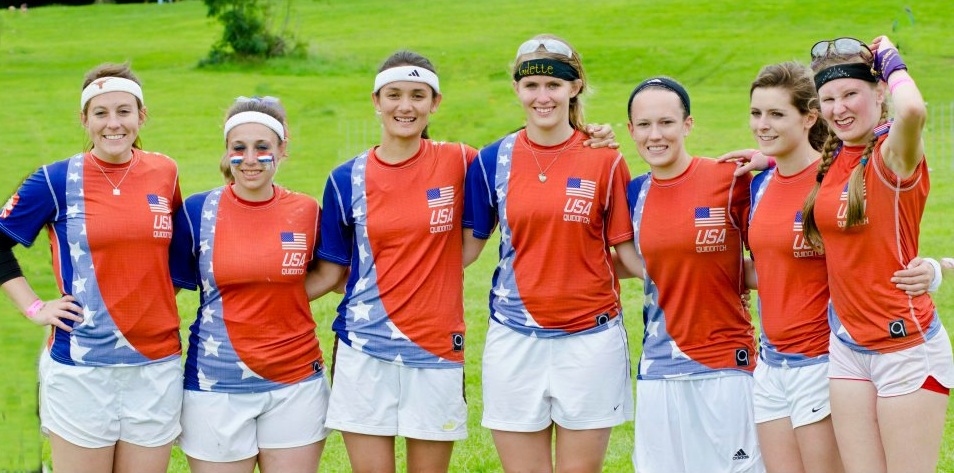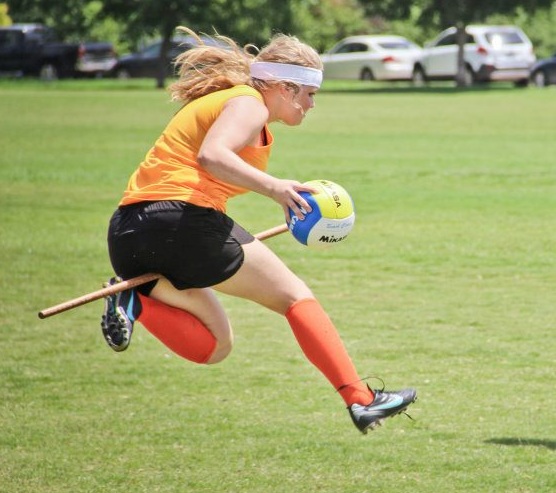- Rule, Britannia, no more?
- Unpopular Opinions: US Quadball Cup 2023
- Proven Contenders: University of Virginia
- Proven Contenders: Rutgers University
- Proven Contenders: University of Michigan
- Proven Contenders: Creighton University
- Different Perspectives: A Look Inside USA Ultimate
- Antwerp QC, Much of Belgian Core, Leaves Competitive Quidditch
Redefining the Standard
- Updated: December 14, 2012


Team USA brought together some of the game’s most talented female players, a testament to how far we have come. Credit: Vanessa Goh
Quidditch is unique.
It’s something no one can disagree with. We run on brooms, we play with four active game balls, we end our games by catching a tennis ball in a sock out of the shorts of a person dressed in yellow, and the love and acceptance our community exudes towards one another would put any anti-bullying ad to shame.
But, to me, the most unique aspect of quidditch is that it is a coed, full-contact, team sport. Sure, college intramural sports and adult sports leagues are proponents of coed teams, but they often handicap with rules such as women’s goals counting for double, while quidditch has everyone play on an even playing field. They are also recreational leagues, while quidditch is coed at its highest level of competition.
As a generalization, men are better than women at most sports. There are plenty of exceptions out there, and this obviously isn’t the case in every instance in which you compare a male and a female player, but looking at the best of the best on a scale such as the Olympics, it is easy to see in the numbers that men have the physical advantage.
Men have this advantage mainly due to genetics, but also because they get priority in regards to coaching from a very young age. Men’s sports remain more prominent worldwide, and many women’s professional sports struggle to even tread water. While league’s like the National Football League bring in billions of dollars, those like Women’s Professional Soccer are forced to shut their doors, closing off an avenue for elite female athletes to grow and prosper.
Another factor working against women in sports is societal views, largely based in past stereotypes. These views are changing, but it is a slow process. Title IX and other women’s rights initiatives are providing the opportunities, which is great, but society still imprints upon women at a young age to fit a certain mold that is deemed acceptable. That mold contains relatively strict guidelines on how a woman should look, and one commonly accepted guideline is that having “too much muscle” is a no-no.
During the Summer Olympics in London this summer some people remarked on how “manly” a number of the female athletes looked with a very negative connotation. In high school, some of my soccer team nicknamed me “Manly Man” because I had relatively defined arm muscles for a girl, and they made me feel very embarrassed about it, as though it was abnormal. At the time I just laughed it off, but now I see the bigger picture.
In general women are discouraged from building up too much muscle while men, who already naturally have more muscle mass, are encouraged to continue to build it up. Based on this fact alone, by the late teenage years, there are vast differences between men and women in athletics.
Revisiting the coaching issue, coaches for men and women’s teams train very differently based on gender. Coaches for men’s teams seem to push them more and teach them more difficult skills at a younger age. Using high school soccer again as an example, our men’s team would consistently run about two miles before every practice while we usually just ran around the field once or twice.
This wasn’t a one-time thing – it’s a theme I noticed ever since starting to play soccer competitively when I was 11. It seemed like the men’s teams generally had tougher conditioning, more demanding practices, etc.
My point in bringing all of this up is that quidditch has a chance to redefine the standard. We can break the mold and facilitate change. The gender rule doesn’t necessarily support equality in terms of allowing the best players regardless of gender on a team to always play, but it is providing for an interesting dynamic to the game that forces every player to grow as an athlete in ways they never imagined before.
Imagine a time years down the road. Kidditch teams are competing against each other in youth leagues of all ages. There will be little girls and boys practicing and developing together on the same team with no special treatment designated to a specific gender. Then think about the college students, where players of both genders have become so developed that a gender rule isn’t even needed anymore. Men and women are widely perceived as equal on the pitch, and teams would naturally include both genders.
So how exactly are women impacting the game? And how can they continue to impact it in a positive way? Well, a lot of it stems from the fact that they play the game differently.
I remember when I first joined the Texas A&M quidditch team. I was recruited by a friend who sold quidditch to me as an awesome sport and told me that they really needed some athletic girls. Back then, having girls that were athletic seemed to be one of the main differences between a good team and a bad team, but most of us were just there on the field making a few plays every now and then while the guys handled the majority of gameplay.
Today, it isn’t enough to just have athletic female players. Teams must adapt to having both genders work seamlessly together as one unit. Obviously, this is the common goal of a team: to play together and not as individuals. But, for quidditch, it’s more complex and difficult than people realize, especially because men and women have a history of not understanding each other in everyday life. What this means is that a successful team today is one whose men and women can adapt to each other.
Because of the physical differences between the genders, each needs to be played in different roles. Most female chasers won’t be able to bulldoze down a field in a situation where the opposing team has no bludgers in the way many top male chasers can. They also may not be as conditioned through their sports background for the full contact styles that are coming more and more common in the game.
The key to overcoming these hurdles is playing to your strengths. One of the most basic, as much as I hate to say it, is your gender. Many male players will take female players for granted and avoid tackling or beating them, focusing their attention on their male compatriots.
But because male chasers have predominantly been the ones to carry the quaffle down field and making drives at the goals, female players have adapted and learned the perfect angles to run and positions to be in to receive a pass. This strength developed from previous lack of trust displayed by male players who felt more comfortable passing to each other or driving to the goals themselves without help. Female players learned that they had to build their teammates’ trust by being as wide open as possible to alleviate the supposed risk of passing to them, and have improved vastly because of it.
So exploit these opportunities when they are given to you. Find space in the opponent’s zone for a quick catch and shoot. Hit them hard when they aren’t expecting it, and make them respect you for the rest of the game – it can go a long way in throwing off their strategy.

Melissa White, who played on a chaser line with fellow Team USA selections Sarah Holub and Jess Klein at Southwest Fantasy, is one of many female chasers redefining how women play the position. Credit: Lauren Carter
As a beater, you can also exploit advantages by breaking stereotypes. There are few things as terrifying for opposing offenses as a talented female beater that is also aggressive. Teams that are used to a female beater sitting near the hoops will struggle to adjust, potentially losing five or six valuable possessions before even beginning to put things together. At that point, it could very well be too late.
I have noticed many female beaters are rather conservative with their bludger and are very particular about when they will take the risk to make a throw. On the other hand, male beaters are more inclined to attempt long shots or react quickly to make a beat without worrying as much about losing their bludger. The yin and yang are glaringly obvious, but when both these styles are integrated and encouraged, the product is a very tough defense. Diversifying your skills is always a great way to improve your overall game, learn from what your teammate does, whether you are male or female. But, at the same time, you should play to your strengths or, as a coach, make sure your team is playing to theirs.
One area I’d love to see more of an increase in female presence is as a quaffle carrier. I rarely see a women bringing up the quaffle, but when they do, some really great things happen. Women seem more patient and more inclined to pass than many men, who can get selfish with the desire to score at the forefront of their mind.
The best distributors in any sport are the players that can be the least selfish. This isn’t to say that men are always more so than women, but in quidditch men have previously been the ones to where the responsibility of scoring has fallen. Because of this, scoring is naturally at the forefront of their minds. With teams evolving to be more than just a one man, they need to adjust who their initial distributors are, and female players are great candidates to fill this role.
These examples are only some of the strengths female players have in quidditch – there’s a lot more room to grow. It can be difficult to see all of the potential because most female players have a lot of growing left to do.
While I hope quidditch survives in the long run, I can understand if it never becomes much more than a quirky college sport. Regardless, we are still redefining a standard in sports by demonstrating the potential of high level coed teams and perpetuating the idea that women can be successful on these teams – instead of just being a novelty. We are carrying with us this new standard we have played by, a standard that someday we can impart on our children as we teach them the game we love so much.

7 Comments